|
|
 |
|
Gardening Blog
|
 |
|
|
Thursday, March 31, 2011
Insects of Spring
There are several insects that cause aggravation out in the
landscape now that the weather is warming up.
Oak Leaftier/Oak Leafroller
If
you have oak trees, you may have noticed the small green or tan caterpillars repelling down from the tree canopy on fine silk
threads. These caterpillars are either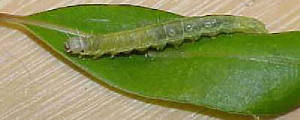 Oak Leaftier or Oak Leafroller caterpillars. Eggs
hatch in early spring, at the same time as the new leaves are emerging. The
larvae feed on the newly expanded leaves this time of year and then spin a web down to the leaf litter to complete their life
cycle. By midsummer they emerge as small moths,
mate, and the females lay their eggs in bark crevices to overwinter. Oak Leaftier or Oak Leafroller caterpillars. Eggs
hatch in early spring, at the same time as the new leaves are emerging. The
larvae feed on the newly expanded leaves this time of year and then spin a web down to the leaf litter to complete their life
cycle. By midsummer they emerge as small moths,
mate, and the females lay their eggs in bark crevices to overwinter.
There are especially large numbers of them this year.
The population of these caterpillars is highly variable, so many years you may not notice them at all.
Larvae create a public nuisance due to their habit of dropping
down from trees on a silk thread.
This particular pest can cause some leaf loss for the trees, but this is usually
not very damaging. Natural control factors (predators,
parasites, and diseases) usually keep leafroller populations at low levels. Outbreaks do occur, but generally decline within
2-3 years. There is no practical chemical control
for them, so wait a few weeks and they will be gone.
Southern Lubber Grasshoppers
You may be familiar with this pest from summers past. They are large yellow grasshoppers with
red and black markings. Lubbers eat a number of plant species and large numbers of them can do extensive
damage. They have very few natural enemies so, controlling them is a challenge. 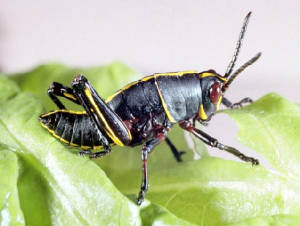
Young nymphs are emerging from the ground now and this is the best time to control them. The
nymphs are small and black with yellow or red markings. At this stage the nymphs are usually congregated
together in large numbers. These pests can be controlled by picking them off and putting them into plastic
bags or buckets of soapy water at anytime during their life cycle. If you prefer chemical control, you can use Sevin dust (carbaryl) or spray while they
are still in the black or dark brown nymph stage. It is best to spray the insects directly since the residue
left on the plant may not be enough to kill them.
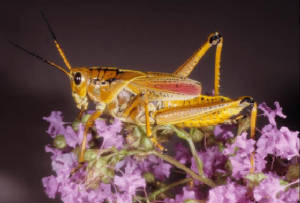 By the time these pests reach adulthood,
they are more solitary and dispersed. Controlling these large adults with chemicals does not really work.
Your best bet is to pick them off and drown them in soapy water. You could always pay a kid to do
this for you. By the time these pests reach adulthood,
they are more solitary and dispersed. Controlling these large adults with chemicals does not really work.
Your best bet is to pick them off and drown them in soapy water. You could always pay a kid to do
this for you.
Controlling
Chinch Bugs in St. Augustinegrass
By JANE MORSE, UF/IFAS Extension Agent
In this
area, chinch bugs are an all-too-common lawn pest of St. Augustinegrass that, unless treated, can cause
real damage. Chinch bugs suck the sap from grass and once an area of your lawn is dead, they will move
on to neighboring areas. Damage may occur in open, sunny areas near sidewalks and driveways, but also in the middle of lawns.
Infested plants grow slower, turn yellow, then rusty reddish-brown, and die.
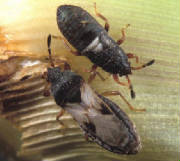 Before starting any treatment, make sure it’s really chinch bugs that are causing the grass to die. Adults
are only an eighth to a tenth of an inch long. The wings are folded flat on the back and are shiny white with a triangular-shaped
black marking in the middle of the outer edge of each wing. Before starting any treatment, make sure it’s really chinch bugs that are causing the grass to die. Adults
are only an eighth to a tenth of an inch long. The wings are folded flat on the back and are shiny white with a triangular-shaped
black marking in the middle of the outer edge of each wing.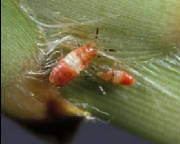 Nymphs (the juvenile stage) are a red-orange color with a white band. They darken as they mature,
which takes about four or five weeks. Nymphs (the juvenile stage) are a red-orange color with a white band. They darken as they mature,
which takes about four or five weeks.
To look for these bugs, try one of these methods:
■
The easiest and fastest is to part the
grass near yellowed areas and look at the soil surface and thatch (brown, dead stuff between the soil and the grass). Pull out individual grass plants and look inside the bottom leaf sheath.
Look in several different areas
if chinch bugs aren't immediately found. The best time to look for these insects is on warm, sunny days at mid-afternoon when they aremost active.
■ Another option is to use a Dust Buster or hand-held vacuum cleaner (electric or battery-operated)
to suck up any chinch bugs near damaged areas. Remove the filter, empty the contents on the sidewalk or in a bucket, and look
for nymphs and adults. Repeat in several damaged areas.
If you don’t find chinch bugs, the culprit could be as simple as an animal using the area as a toilet; a sprinkler
head not working properly; or a disease.
If you do find lots of chinch bugs, then it is time
to treat the lawn. The first thing to apply might be a neonicotinoid product such as Merit. It is best
to use spot treatments when small infestations are first noticed and damage is minimal. Treat dead and
dying St. Augustinegrass and about a five-foot buffer area around the damage. This should do the trick for a couple of months.
If you start seeing damage come summertime then apply either a pyrethroid, organophosphate or carbamate product. You can find
a list of products at http://edis.ifas.ufl.edu/lh036
Chinch bugs are becoming resistant to insecticides. To keep this from happening it is very important to rotate between
the different chemical modes of action. There are four different chemical modes of action available for use: neonicotinoid,
pyrethroid, organophosphate and carbamate. Use one of these chemical modes of action for the first treatment, then pick a
different mode of action for the second treatment, and a different mode for the third treatment and so on. Any
combination of the four will do, just be sure to rotate to a new mode of action for each treatment.
There also are some cultural practices that will lessen chinch bug reproduction and survival.
Use slow release nitrogen products and only apply the recommended amount or less. Mow standard St. Augustinegrass at a height
of four inches and mow frequently enough to only remove a third of the leaf blade. Water only when the grass starts to wilt.
If thatch develops it usually indicates over-watering and over-fertilizing. You may need to have the lawn verticut to remove
the excess thatch.
There are natural biological
controls that help keep chinch bug populations in check. Preserve “good bugs” by doing spot applications when
spraying pesticides. “Good bugs”, such as big-eyed bugs and minute pirate bugs, are similar
in size and shape to chinch bugs and can be mistaken for chinch bugs.
In summary, identify the pest, use spot treatments, rotate between the different modes of action, and use good cultural
practices. Always read and follow the pesticide label.
All pictures in this post are from University of Florida/IFAS publications.
11:56 am edt
Thursday, March 10, 2011
Cold Hardy Landscape Alternatives
A number of our landscape plants here in north Pinellas County
have once again been killed or damaged by our second cold winter in a row. I hope this is not going to
be the normal temperature patterns for our next winters. I have put together a group of cold hardy plants
that can be used instead of the more common plants that are damaged when we have freezes. 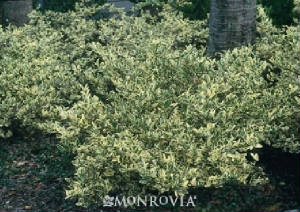
Shrubs:
‘Jack Frost’ Ligustrum has variegated green accented with creamy yellow foliage that is not be damaged
by frost or freeze. This shrub makes a good alternative to Gold Mound Duranta and can be planted in part
shade to full sun.
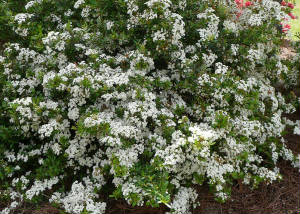 ‘Mrs. Schiller’s Delight’ Dwarf
Walter’s Viburnum is a dense native shrub with small dark green leaves
that naturally grows to form a four foot ball of foliage that does not require frequent pruning. It is
covered with small white flowers nearly all year and is very freeze tolerant. It grows well in full sun
and shade, but will bloom best grown in the sun. ‘Mrs. Schiller’s Delight’ Dwarf
Walter’s Viburnum is a dense native shrub with small dark green leaves
that naturally grows to form a four foot ball of foliage that does not require frequent pruning. It is
covered with small white flowers nearly all year and is very freeze tolerant. It grows well in full sun
and shade, but will bloom best grown in the sun.
‘Purple Pixie’ Loropetalum
has small burgundy leaves on branches with a weeping habit.
It grows about two feet tall and 4 feet wide with bright pink ribbon-like flowers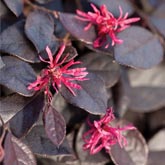 in the early spring. Planted in full sun or part shade, Loropetalum can make a good substitute for Crotons
if you need some color in the landscape. in the early spring. Planted in full sun or part shade, Loropetalum can make a good substitute for Crotons
if you need some color in the landscape.
‘Purple Diamond’
Loropetalum also has small burgundy leaves and bright pink
spring flowers. It grows larger at four to five feet tall and wide. It will make a nice
hedge in part or full sun.
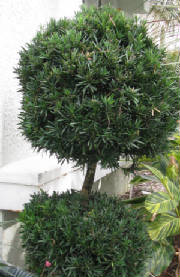
Podocarpus Topiary is a
good alternative to the Eugenia topiaries that are readily available for sale, but always seem to be damaged by frosts and
freezes. Podocarpus is very cold hardy and takes pruning and shaping well. Topiaries
of Podocarpus are harder to find, but worth the search. I have one in my yard that has never shown any
cold damage.
Palms:
European
Fan Palm is a small slow-growing palm that will form clumps of new palms as it ages. They grow to about 15 feet tall and would make a good alternative
to the Pigmy Date Palms that have been damaged the last few years, especially if you are tired of pruning off the mass of
brown fronds each spring from the pigmy’s. There are multiple trunks and the fan shaped fronds are
either blue-green or green. form clumps of new palms as it ages. They grow to about 15 feet tall and would make a good alternative
to the Pigmy Date Palms that have been damaged the last few years, especially if you are tired of pruning off the mass of
brown fronds each spring from the pigmy’s. There are multiple trunks and the fan shaped fronds are
either blue-green or green.
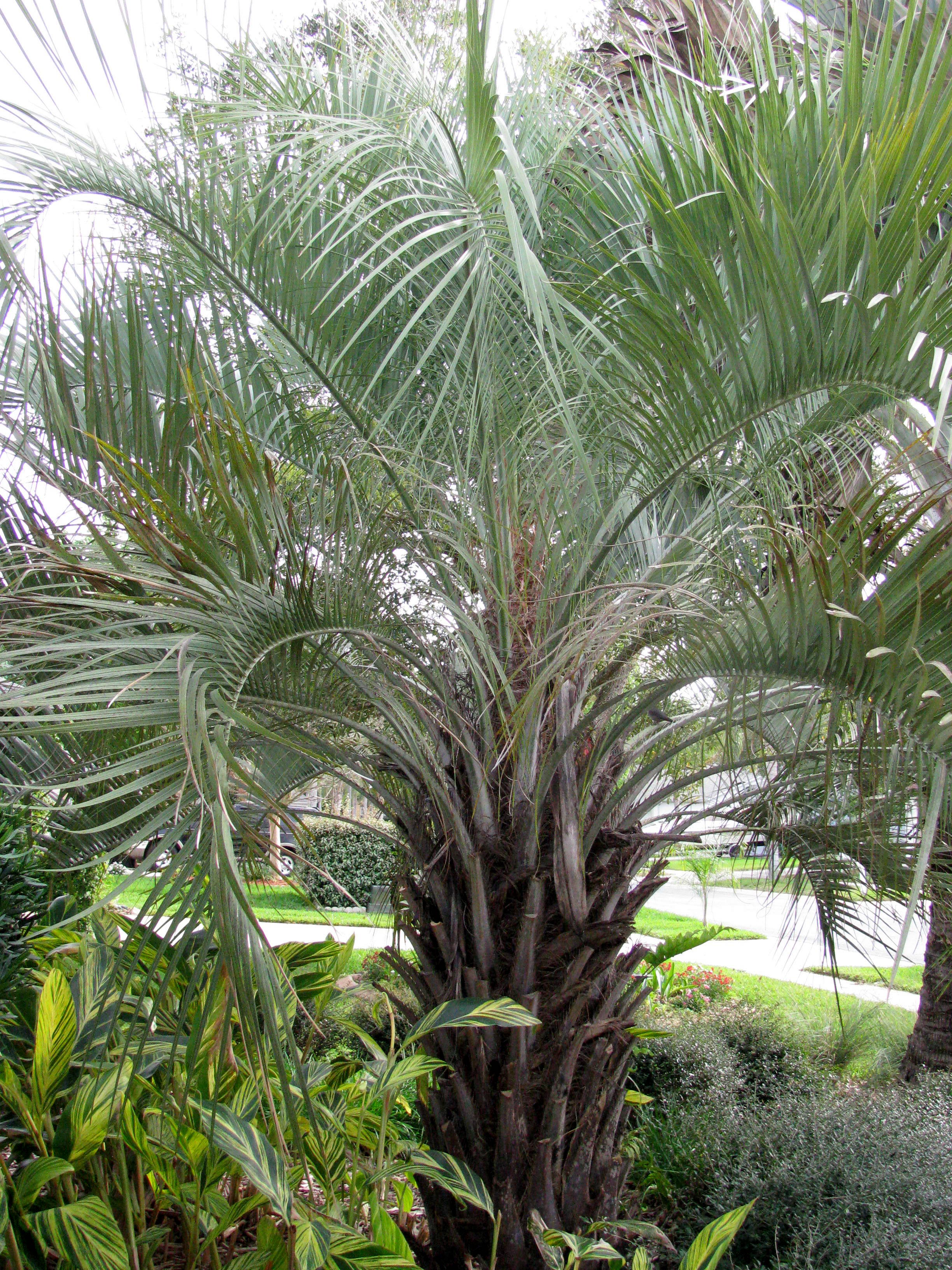
Pindo Palm is a single-trunked palm with a rounded canopy of blue-grey fronds which curve in toward the trunk. The
stocky trunks are covered with persistent leaf bases. The fruit, ripening in summer, can be messy on sidewalks or patios,
so you may want to plant 10 feet away from the walk or patio. This slow-growing palm eventually will reach 20 feet tall.
Perennial
Flowers:
African Bush Daisy (Euryops
chrysanthemoides) is a small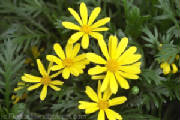 shrub that grows in a mound-like bush up to three feet tall and wide. It has dark glossy-green, lacy leaves. The yellow flowers
look like daisies. Peak flowering is in autumn-winter-spring, but flowers are usually found on the bush throughout the year.
This lovely flowering plant is
evergreen and tolerates light frost and moderate freezing temperatures. shrub that grows in a mound-like bush up to three feet tall and wide. It has dark glossy-green, lacy leaves. The yellow flowers
look like daisies. Peak flowering is in autumn-winter-spring, but flowers are usually found on the bush throughout the year.
This lovely flowering plant is
evergreen and tolerates light frost and moderate freezing temperatures.
 Bulbine (Bulbine
frutescens) is also called Jelly Burn Plant because it is similar to Aloe. It contains the same glycoprotiens
that can ease burns. This plant has either orange or yellow blooms nearly year round and is hardy down
to 20 degrees. I have found
that the yellow blooming variety seems more robust during the summer months. Bulbine is a succulent and
very drought tolerant. It appreciates a hot, dry location. Bulbine (Bulbine
frutescens) is also called Jelly Burn Plant because it is similar to Aloe. It contains the same glycoprotiens
that can ease burns. This plant has either orange or yellow blooms nearly year round and is hardy down
to 20 degrees. I have found
that the yellow blooming variety seems more robust during the summer months. Bulbine is a succulent and
very drought tolerant. It appreciates a hot, dry location.
Replacing any of the plants in your landscape that were badly damaged this past
winter with one or more of the plants listed above will assure less damage in any future bad winters.
Pictures in this post from the following sources:
Bulbine: Pam Brown
Walter's viburnum: LSU Agg Center
Jack Frost: Monrovia Nursery
European fan palm: Broward Palms
Loropetalum:
Southern Living Plants
African Bush Daisy: Florida Friendly Plants
Pindo palm: Pam Brown
Podocarpus topiary:
Pam Brown
4:29 pm est
|
|
To subscribe to this blog - click on XML icon.
|
 |
|
|
|
 |
|
|
Pampered Gardeners LLC * Oldsmar, FL * USA * Phone: 727 483-3783 * pam@pamperedgardeners.com
|
|
|
 |

